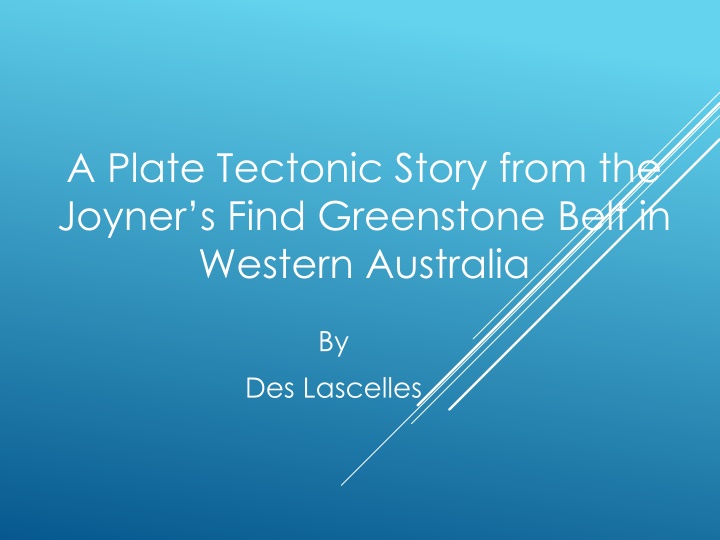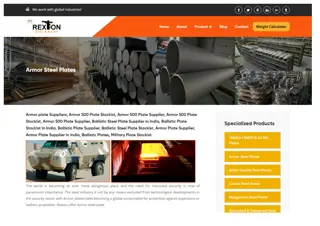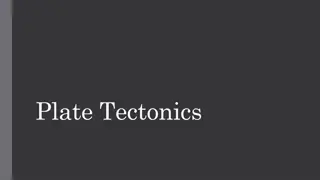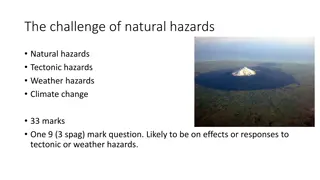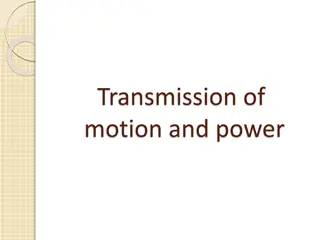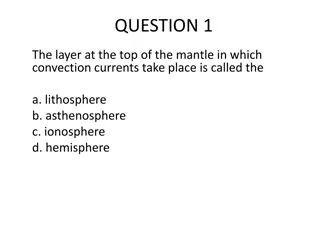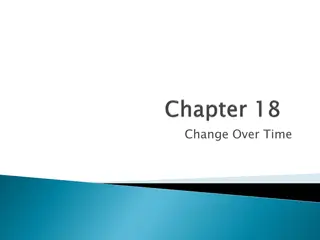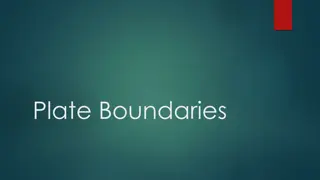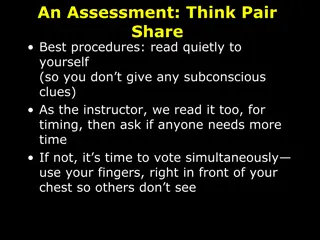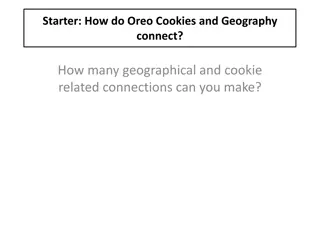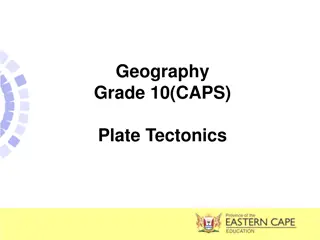The Plate Tectonic Story of Joyner's Find Greenstone Belt in Western Australia
The Joyner's Find Greenstone Belt in Western Australia lies near the Yilgarn Craton and offers insights into early Archean history through its geological mapping and stratigraphy. This small greenstone belt features mafic volcanic rocks, banded iron formations, and siliciclastic sediments, forming a unique geological sequence. The presence of iron formations and other geological features suggest its proximity to a spreading centre during its formation.
Download Presentation

Please find below an Image/Link to download the presentation.
The content on the website is provided AS IS for your information and personal use only. It may not be sold, licensed, or shared on other websites without obtaining consent from the author.If you encounter any issues during the download, it is possible that the publisher has removed the file from their server.
You are allowed to download the files provided on this website for personal or commercial use, subject to the condition that they are used lawfully. All files are the property of their respective owners.
The content on the website is provided AS IS for your information and personal use only. It may not be sold, licensed, or shared on other websites without obtaining consent from the author.
E N D
Presentation Transcript
A Plate Tectonic Story from the Joyner s Find Greenstone Belt in Western Australia By Des Lascelles
The Western Australian Craton The Joyner s Find Greenstone Belt lies close to the northern margin of the Yilgarn Craton in Western Australia Pilbara Craton N Hamersley Basin Joyner s Find Greenstone Belt Yerrida Basin Earaheedy Basin WILUNA It is one of the smallest greenstone belts being only 45 km long and 10 km wide (exposed portion) and this assisted in determining its relatively simple geology Murchison Dom ain Eastern Goldfields Terrane Youanm i Terrane Yilgarn Craton Southern Cross Dom ain PERTH Southwest Province
Geological Mapping The detailed surface geological mapping of the Joyner s Find greenstone belt produced new insights into the early Archean history of plate tectonics. 790000E 795000E 800000E 785000E 7060000N B A 7,045,000 mN 7055000N Proterozoic cover 7050000N 7,042,500 mN 7045000N Greenstone Belt 7040000N 7,040,000 mN 7035000N BIF units 7030000N 7,037,500 mN A. The Joyner s Find geology interpreted from regional aeromagnetic data. 7025000N Granite 7,035,000 mN B. Sample of the geology interpreted from field mapping (area shown as white rectangle in A). 7020000N 792,500mE 795,000mE 7015000N Legend Archean Tertiary Ferricrust Glen Group Paleoproterozoic Wilga Mia Fm 7010000N Finlayson Member Meekatharra Fm Archean Yaloginda Fm Granite Fault Murrouli Basalt 700500N Fold axes
Stratigraphy and structure The greenstone belt consisted of a west-facing steeply dipping approximately 5 km thick continuous sequence of mafic to ultramafic volcanic rocks with interbedded banded iron formations (BIF) overlain by 4-5 km of siliciclastic sediments with interbedded mafic volcanic rocks (Table. 1). Stratigraphy of the Joyner s Find greenstone belt Archean Monzogranite intrusion and thermal metamorphism D2 folding and faulting Wattagee Formation Not seen 2637-2602Ma ~2700-2650Ma Glen Group Ryansville Formation Medium to coarse sediments and mafic volcanic rocks 2725-2700Ma (Murchison Supergroup) Wilgie Mia Formation Thick BIF and mafic to ultramafic volcanic rocks Polelle Group Greensleeves Formation Not seen Meekatharra Formation Ultramafic, mafic and minor felsic volcanic rocks 2800-2725Ma Yaloginda Formation Thin BIF with mafic and ultramafic volcanic rocks Norie Group Murrouli Basalt Mafic and ultramafic volcanic rocks 2820-2800Ma
Stratigraphy and structure The greenstone belt was interpreted as a small portion of an extensive deep sea-floor stratigraphic sequence of mafic to ultramafic lavas and hydrothermal chemical deposits (BIF) probably deposited directly on the mantle. Ocean 2 km Glen Group Wilga Mia Fm Meekatharra Fm Yaloginda Fm 15 km Neither the base nor the top of the sequence was seen due to anatexis with the remnant forming a roof pendant in the granite batholith. Murrouli Basalt Mantle The presence of iron formation turbidity current deposits in the Yaloginda Formation suggests that the JFGB was initially close to the spreading centre and source of the Murrouli Basalt while the thick deposit of siliciclastic sediment at the top of the sequence indicates proximity to an older granitic craton during the closing stage.
Cross-section of the Joyners Find Greenstone Belt Legend Archean Anatectic granite Murchison Supergroup Glen Group Wilgie Mia Formation Meekathara Formation Yaloginda Formation Murrouli Basalt Banded Iron Formation Shear Zones 10 km The sequence of rocks in the greenstone belt comprised a small portion of the west-facing limb of a very large fold system with only minor repetition of strata due to subsidiary folding in the BIF units. Contacts with the surrounding granite showed anatectic in situ replacement and the mineralogy indicated purely thermal metamorphism to greenschist facies rising to amphibolite facies and granulite facies close to the granite. Numerous N-S trending shear zones enclosed blocks of undeformed strata apart from tight isoclinal minor folds in the BIF units with no observable evidence of subsidiary folding in the mafic and ultramafic volcanic rocks
Present cross section of lithosphere beneath the Joyner s Find Greenstone Belt Replacement of the down-folded ocean crust by granite and erosion of the upper parts of the folds reduced the mass of the fold belt forcing uplift of the belt leaving a craton thickness of around 30-35 km Present land surface JFGB Eastern Golfields Terrane Youanmi Terrane Ida Fault 35 km Granitic craton The numerous shear zones postdate the granite and are associated with movement on the Ida Fault - a major suture between the Youanmi Terrane and the Eastern Goldfields Terrane Ultramafic mantle
INTERPRETATIONS AND CONCLUSIONS
Stratigraphic interpretation 1. Partial melting of the hot mantle in an upwelling convection current causes production of ultramafic magma which erupts over the surface of the mantle and cools to form a crust. Overturn of the mantle convection current drags on the solidified crust causing rifting and the formation of crustal plates. Interaction between seawater and hot lava occurs producing hydrothermal vents precipitating mounds of iron silicates and iron hydroxides around the vents. (Estimated depth of ocean ~2 km) 4. The mounds collapse producing turbidity currents (TC) carrying the coarser particles and density currents carrying colloidal particles. 5. The turbidity currents drop their loads close to the source but density currents flow all the way across the sea floor. 6. The presence of turbidites (Granular Iron Formations) indicates deposition of the Yaloginda Formation close to the hydrothermal vents Hydrothermal vents Ocean Rift (TC) Y a lo g i n d a F m M u r ro u li B a s a l t 2. M a n tl e flo w 3.
Ocean (DC) Wilga Mia Fm As the crustal plate moves away from the rift the character of sedimentary and volcanic deposition changes. Meekatharra Fm (DC) (TC) Yaloginda Fm Murrouli Basalt Mantle flow 1. Granular iron formations give way to thin banded iron formations (density current deposits, DC ) in the upper Yaloginda Formation. 2. Followed by a thick sequence of mafic to ultramafic lavas with minor felsic flows in the Meekatharra Formation. 3. Thick banded iron formation (DC) units of the Wilgie Mia Formation are deposited interbedded with mafic lava flows.
The mantle loses heat through the crust as it flows away from the upwelling convection current and becomes cooler and denser, finally sinking back down. Ocean At the final stage of deposition of the Granitic craton Glen Group Joyner s Find greenstone belt, the oceanic Wilga Mia Fm Meekatharra Fm sediments are buried beneath the Glen Yaloginda Fm Murrouli Basalt Group sequence of siliclastic turbidites and gravels derived from an ancient Mantle flow continental craton.
Structural interpretation It was assumed that the tight isoclinal folding in the BIF units reflected the overall style of the major fold but remarkably, given the intensity of the folding, there was no evidence of dynamic metamorphism or cleavage development. Extrapolation of the fold from the partial limb suggests that an overall thickness of the strata of 10 - 15 km was involved and constituted the whole of the oceanic crust down to the mantle, thus giving the folds a total amplitude of up to 100 km. Removed by erosion 100 km The depressed into the mantle by isostatic compensation with consequent partial melting and separation of granite from a dense ultramafic restite. folded crust would be deeply Replaced by granite Mantle 60 km
Application to lithosphere evolution The origin of Archean Cratons Rift Shallow ocean Compression Expansion Crust Folded crust Mantle convection MANTLE Mantle convection As the plates above two converging mantle convection currents collide the ocean crust is deformed into multi-kilometre scale folds. The converging currents of cooler and denser mantle material are deflected downward completing the convection current cycle. The folded crust is deeply depressed into the mantle by isostatic balance
RIFT Shallow ocean Granite Crust Zone of Partial melting Mantle convection MANTLE Mantle convection Dense restite The cooled mantle is still hot enough to cause partial melting of the depressed folded crust but only affects the least refractory felsic components resulting in the separation of granitic magma from a dense restite.
RIFT Shallow ocean New granite craton Crust Mantle convection Mantle convection MANTLE Prolonged erosion of the folded crust and separation of the dense restite allows uplift of the newly formed granite. The cooler restite and the mantle that has lost heat through the crust sinks down to the base of the mantle and terminates the mantleconvection.
Greenstone belts Ocean Ocean crust Archean craton Ocean crust MANTLE Mantle Erosion reduces the surface to a low lying landscape and the craton stabilises. Remnants of the folded ocean crust remain as greenstone belts on top of the craton.
Archean cratons to modern continents The change to modern subduction plate tectonics Ocean Archean craton Sediment Ocean crust MANTLE Mantle Sediment from subaerial erosion of the uplifted craton surface including mafic lava flows is deposited on the thin passive margins of the craton. The added mass causes stress that is relieved by faulting and depression of the craton margin.
Archean craton Ocean Ocean floor sediments Ocean crust MANTLE Mantle The surface of the basin is depressed to the level of the ocean floor and thick sequences of ocean sediments and volcanic rocks are deposited, including banded iron formations. (vertical scale greatly exaggerated)
Archean craton Ocean Ocean crust MANTLE Mantle The marginal basin becomes a fixed part of the craton. Continued uplift of the craton due to erosional unloading causes the supply of ocean floor sedimentation to be cut off and the marginal basin is filled by shallow water sediments.
Marginal basin A rc h e a n c ra t o n Ocean Geosyncline ocean crust Fault Fault M a n t le M A N T L E Continued uplift starts erosion of the marginal basin as well as the craton and a thick pile of sediments accumulate on the ocean floor forming a major sedimentary basin (geosyncline) and depressing the ocean crust.
Orogenic belt Marginal basin A rc h e a n c ra t o n Ocean ocean crust M a n t le The deep sedimentary basin is compressed and then accreted on to the continent. The ocean crust is then forced beneath the buoyant sedimentary basin and continent and subducted down into the mantle thus initiating the subduction phase of plate tectonics.
